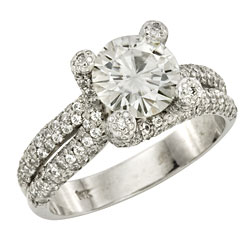Nowadays, choosing a diamond simulant is a smart, viable choice for many. But still, people want to know how you tell the difference between a fake and real diamond. This article covers the basics, for the skeptical and curious:
To understand how to tell a cubic zirconia from a diamond, it is important to have a better understanding of what this particular stone is and why it looks so much like an expensive diamond. Cubic zirconia is a synthetic material made from zirconium dioxide. The material is extremely hard, strong, virtually flawless from a visual perspective, and colorless, although cubic zirconia can be produced in numerous colors.
One of the primary benefits of cubic zirconia is affordability. Obviously, diamonds are expensive, one of the most expensive of all precious stones. For this reason, if people can purchase a material that looks like a real diamond, has strong and durable qualities, and costs a fraction of what a diamond costs, it is easy to see why a cubic zirconia is so popular. However, with all the benefits, nothing can take the place of a diamond. Now understanding what cubic zirconia is, individuals need to know how to tell a cubic zirconia from a diamond.
Again, the main reason for learning how to tell a cubic zirconia from a diamond is to avoid being scammed. If a person were to sell existing jewelry, he or she needs to know without doubt pieces being sold are actually diamonds. Then, for buying, unfortunately it would be easy for someone to become caught up in fraud, spending hard-earned money on a fake stone. While this might sound farfetched, the truth is this happens often.
The good news is that there are a number of easy tests that will help to determine whether a stone is cubic zirconia or diamond. For starters, there is the old method of scratching glass. If a piece of jewelry made with a cubic zirconia were to be run across a piece of glass, nothing would happen to the glass but the faux stone might scratch. However, if a real diamond were run across a piece of glass, the diamond would likely be undamaged and the glass scratched. The only downside to this particular test on how to tell a cubic zirconia from a diamond is that some of the higher quality faux stones are now made so well they can produce a small scratch on the glass.
Another method to tell cubic zirconia from diamond has to do with the stone’s transparency. Real diamonds are cut, producing facets on the inside. Because of the many lines, seeing through a real diamond is near impossible. For this technique, simply place a piece of newspaper behind the stone. If the print is readable the stone is a cubic zirconia but if not, the stone is a diamond.
The fog technique is an accurate and easy test to perform. To check the stone, simply breathe on it. The reason this is so reliable is that a real diamond is not capable of holding heat. Therefore, after breathing on the stone if it becomes fogged over, it is a cubic zirconia whereas if the warm breath clears up immediately, the stone is an actual diamond.
Now, people can go a little more high tech by using ultraviolet lighting. Officially known as an AUV test, the outcome would be based on the amount of fluorescent color produced. For instance, if the stone were a real diamond, it would show up as florescent color under the ultraviolet lighting. However, cubic zirconia stones would have no fluorescent color.
Another test that works amazingly well has to do with weight. The fact is that a real diamond weighs as much as 50% less than a cubic zirconia stone would weigh. Using a gram scale, the stone could be weighed against a confirmed diamond and the weight would show the stone to be real or fake. Obviously, the two stones should be the same carat to get the best results.
One last test that could be tried uses a loupe. Typically, this type of test is performed by a professional gemologist but anyone who knows how to look at stones through a loupe could do this. The purpose of this test is to look closely at the stone’s characteristic makeup, which includes the inside facets and girdle. A cubic zirconia stone will usually have a waxy appearance whereas a real diamond would be clear. Finally, some cubic zirconia stones will actually have the initials CZ stamped on the inside of the jewelry piece and a loupe would help reveal this.
Source: Abazias Diamonds
Style 10310-
Save 40% Custom Created Moissanite Engagement Ring Wtih Pave CZ Side Stones
Custom created engagement ring with a 1.50ct (dia equiv) Charles and Colvard created round brilliant moissanite center and nearly 200 round cubic zirconia pave’ side stones in 14kt white gold, one piece only in ring size 7.
Save 40%! Use the coupon code below for discount at the end of the checkout process.
Our Price: $3,295.00
Sale Price: $1,977.00
Coupon Code For Checkout Discount40

